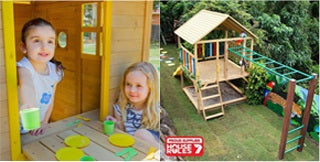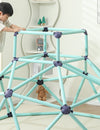The Blog
Incorporating Learning and Play: Educational Activities with Cubby Houses

Incorporating Learning and Play: Educational Activities with Cubby Houses
With childhood play and education becoming increasingly dominated by screens and structured learning environments, the importance of unstructured play in a child's development cannot be overstated. Enter the humble cubby house, a timeless and versatile playground staple enjoyed by generations of Aussie families. These cozy structures provide a place where creativity, social skills and cognitive abilities can flourish organically. Today, we'll be delving into the many ways cubby houses help to incorporate learning and play together, offering a holistic approach to learning that fosters problem-solving, teamwork and imaginative exploration.
The Power of Playful Learning

The ability to integrate play and learning is a powerful tool in early childhood development. Playful learning engages minds, ignites creativity and fosters a love for exploration. Blending the two transforms the learning experience from a routine task to an exciting adventure. As educators, parents or lifelong learners, unlocking the potential of playful learning unlocks a number of benefits - from enhanced problem-solving skills to a deeper understanding of complex concepts. Join us on a journey where the joy of play intertwines seamlessly with the pursuit of knowledge, creating a dynamic landscape where learning is not just absorbed but celebrated.
Why Cubby Houses are great for educational play
Cubby houses are highly effective spaces for educational play, providing a nurturing environment that enriches a child's overall development. Through hands-on activities, these structures encourage experiential learning, sparking creativity and problem-solving skills. Incorporating play windows and sandpits, cubby houses facilitate cognitive development by encouraging observation, interaction and sensory exploration. Moreover, their design promotes the development of crucial social skills, such as sharing, cooperation and taking turns, as children engage in collaborative play experiences. Cubby houses are transformative settings where education seamlessly intertwines with play, nurturing holistic growth and fostering a lifelong love for learning in young minds.
Choosing a Cubby House for Educational Activities

Navigating the selection process for a cubby house dedicated to educational play involves several considerations. Explore the diverse range of cubby types, sizes and incorporated toys/furniture, from classic wooden structures to more elaborate designs, and tailor your choice to suit the preferences and educational needs of your children. Critical to this decision is accounting for the number of children and available outdoor space, ensuring that the selected cubby house provides an inclusive and collaborative environment for optimal learning experiences. By making informed choices in cubby house selection, parents can create an engaging and educational play haven that caters to the unique dynamics of their children and outdoor surroundings.
Strategies to help promote educational play
Unlocking the full educational potential of cubby houses involves strategic approaches that extend beyond their physical structure. Enhance the learning experience by incorporating extra accessories and attachments, such as educational signage and interactive panels, to stimulate curiosity and diversify play. Integrate complementary equipment like play tables and early development toys that seamlessly align with the cubby house environment, fostering creativity and cognitive development. Organising play dates within the cubby house setting encourages social interaction and cooperative play, providing a dynamic space for collaborative learning experiences. By implementing these strategies, parents can transform the cubby house into a place that enriches children's development through play in a holistic and engaging way.
Conclusion

Incorporating education and play is easy the fun with Lifespan Kids' diverse range of cubby houses. Cubby houses serve as ideal educational spaces and hold the transformative power of play learning. Lifespan Kids offers a comprehensive approach to childhood development, offering a wide range of cubby houses and early development toys to enhance educational play. With a range of options designed to cater to different preferences and spaces, Lifespan Kids ensures that every child has access to a vibrant and educational play experience. Connect with us or find your nearest store to explore the many possibilities and create a learning journey that is as unique as each child.















 Shop now, Pay Later
Shop now, Pay Later








